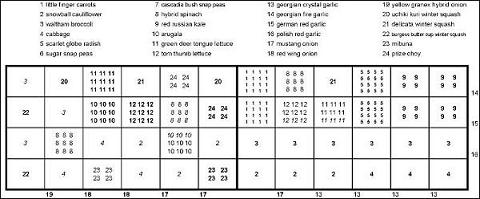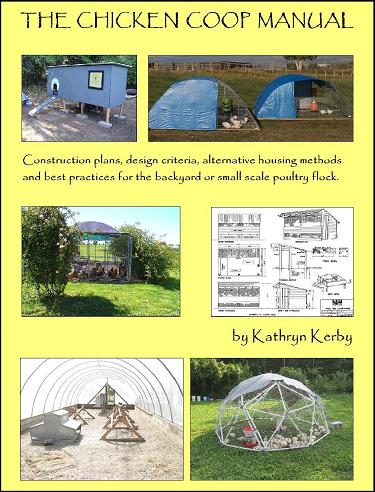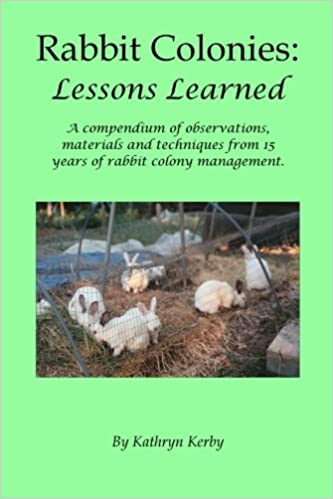In-Soil Growing Methods:
Square Foot Gardening

Square foot gardening has probably come and gone repeatedly throughout human history. But it came to our attention thanks to Mel Bartholomew's book Square Foot Gardening. In that book, he described a surprisingly simple, efficient, and user-friendly way to garden. Namely, set up small square or rectangular planting beds, figure out how much of each plant you want, figure out how much space each plant needs, and give it only that much space. No more, no less. If your plant is a vine, use a trellis to get it off the ground. If your plant trails, stack the planting beds on top of each other so you can grow more plants in the same area. And best of all, he did a lot of the figuring for us in his book. All we had to do was turn to the page for that crop, find out how much room each plant needed, then plug that into our plans and voila! A planting layout for whatever we were going to plant that year.
The results were astounding. Instead of swimming in this variety of squash but not having enough of that herb, we planted exactly what we wanted. No more, no less. And with Mel's methods we were exposed for the very first time to the idea of "cheek to jowl" planting. In other words, plant each seed exactly close enough, so that the growing plants will have plenty of room but the mature plants will be touching leaves. This progressively blocks more and more sunlight to the soil below. This preserves soil moisture in the heat of summer, and helps keep weeds at bay. It was a method that could be (and has been) taught to schoolchildren, yet worked remarkably well for our growing operation.
Even after we graduated from hobbyist gardeners to small scale market growers, we kept many of his concepts firmly in mind. It was hard not to read through various crop layout plants without thinking in terms of square footage of this or that crop. In fact, when we committed to using raised, intensively planted beds rather than single-row layouts, the square foot method again helped us calculate how much room each type of plant needed. It also reminded us to go up as often as possible to maximize the amount of production we could get from any given square foot of ground. It really is a solid, practical approach for growers, regardless of scale.
Our original copy of Mel's book is now dog-eared and stained with the soils of countless gardens, from three different states. I look back on that book often to remind myself of the spacing requirements for a variety of crops, whether we plant ten of them or 500 of them. And I smile as I think about all the weeding, irrigation and tillage work I saved myself by following his methods.
The one thing I don't like about his new book is his strong recommendation to use his particular soil mix. That could be sound advice for folks who have never mixed soils before, or who really are not sure what soils they have. But we're well into our own soil mixing activities so we don't use his particular recipe. Still, he's doing well if that's the only fault we've found after nearly two decades of following his advice.
If you are a beginning grower, or you'd like to find ways to maximize your growing area, you'd be hard pressed to do better than Mel's approach. And as luck would have it, his approach continues to work extremely well as we have scaled up from garden to farm. Not many methods consistently fit that well, over such a long range of years, miles and planting bed sizes.
Which version of Square Foot Gardening is best?
Two different versions of Square Foot Gardening are currently available. The first edition of Square Foot Gardening: A New Way to Garden in Less Space with Less Work
Our Successful Farming and Ranching Books

We released our very first self-published book. The Chicken Coop Manual in 2014. It is a full color guide to conventional and alternative poultry housing options, including 8 conventional stud construction plans, 12 alternative housing methods, and almost 20 different design features. This book is available on Amazon.com and as a PDF download. Please visit The Chicken Coop Manual page for more information.

Rabbit Colonies: Lessons Learned
We started with rabbits in 2002, and we've been experimenting with colony management ever since. Fast forward to 2017, when I decided to write another book, this time about colony management. The book is chock-full of practical information, and is available from both Amazon and as a PDF download. Please visit the Rabbit Colonies page for more information.
The Pastured Pig Handbook
We are currently working on our next self-published book: The Pastured Pig Handbook. This particular book addresses a profitable, popular and successful hog management approach which sadly is not yet well documented. Our handbook, will cover all the various issues involved with pastured hog management, including case studies of numerous current pastured pig operations. If you have any questions about this book, please Contact Us.

Weblog Archives
We published a farm blog between January 2011 and April 2012. We reluctantly ceased writing them due to time constraints, and we hope to begin writing them again someday. In the meantime, we offer a Weblog Archive so that readers can access past blog articles at any time.
If and when we return to writing blogs, we'll post that news here. Until then, happy reading!




